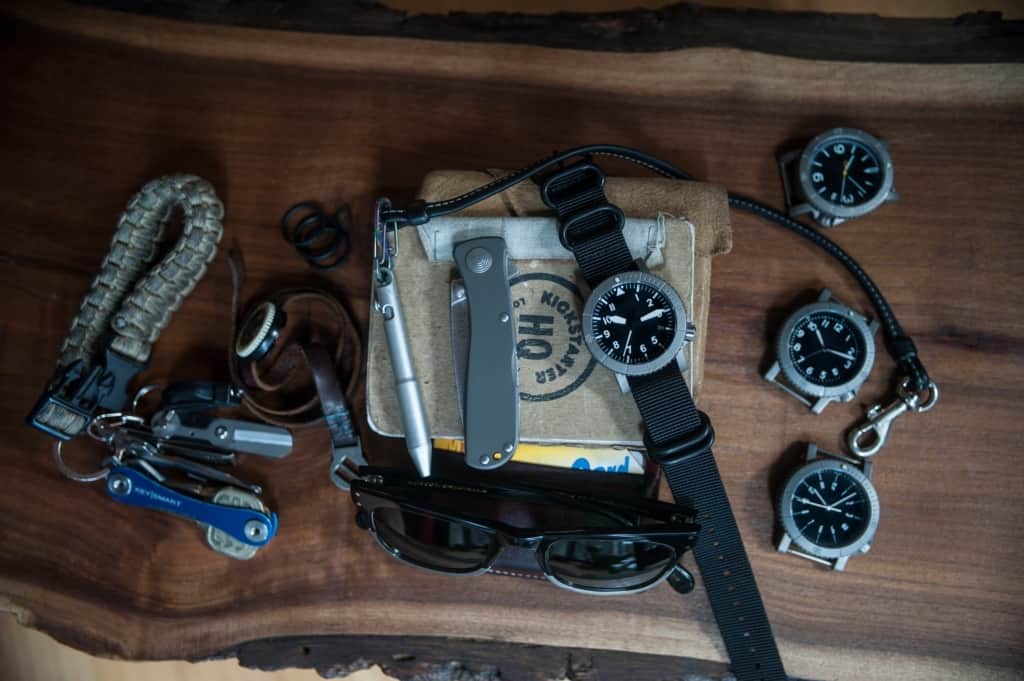It’s no small secret that in the last few years Kickstarter and crowdfunded watches have gone from a cool curiosity to regular occurrence. What once seemed like this miraculous way for young brands to launch their wares is now becoming an all-too-easy method for anyone to create products, good or bad, well-intentioned or not. And they keep coming. As our readers know well, we report on these projects with some regularity… the ones we like that is… and as of late, there has begun to be a bit of backlash. People are getting sick of all the new projects and all the new brands.
Today, I wanted to put together my own thoughts on the matter and address the issue. Here at w&w we easily get a couple of emails a day about new projects on KS or ones about to launch… they far exceed the amount new releases from more established brands, making them simply a good source for stories, when approached with discretion. The abundance, and I really mean it, of projects we see, we pass on. Generic designs, rushed concepts or simply people trying to hop on a trend (see Daniel Wellington or every wood watch) fill most of these pitches, along with tag lines like “redefining luxury” or “I couldn’t find the perfect watch for me, so I designed it myself” (which remarkably almost always leads to designs you could easily find elsewhere). But every now and then, there is either a great project we know everyone will love (see the COURG, StuckX and Nezumi), a gorgeous design that I happen to adore (see Klokers), something brilliant (like the Eone Bradley) or a project that is perhaps a little weak, but has a kernel of something creative or clever (the Boston & Stewill, with its bullhead case and 12 o’clock date).

So, KS campaigns are here to stay so long as the format is around, and as the leading source of news and reviews on affordable timepieces, it’s our job to tell you about the good ones and cool ones. We pride ourselves on covering a wide-but-curated range of what’s available in the watch world, and not just beating the drums of established brands, or watches that are easy wins. We like finding unique watches and putting them in the spotlight, watches that might get otherwise overlooked. By doing this we give them a chance to succeed, but also a chance to fail. A chance to meet the harsh criticisms or enthusiastic accolades of educated watch enthusiasts; aka our readers. In the end of the day, the great thing about the KS format is that you can simply choose not to support a brand. Maybe they’ll succeed, maybe they wont.
But, that just covers our approach to KS campaigns as content on w&w. My thoughts on the matter still run deeper as there are some great things about the format, but also some really bad things. So I’ve broken my thoughts into 3 categories: the good, the bad and the ugly.
please note that all images included are of brands we greatly enjoy that have found success on Kickstarter
The Good
The very nature of Kickstarter is to allow those who might not otherwise be able to fund their project bring them to fruition. This levels the playing field, so to speak, allowing for people whose ideas might otherwise have never been seen to be realized. As a watch fanatic and product designer, I find this both wonderful and exciting. How many Basel’s have left us cold or bored? Big brands are often too conservative and take too long to catch up to trends. Rarely will a watch come out from a big brand that really gets everyone excited (and when they do, us and every other blog will tell you about it ad nauseam). KS projects are immediate and can react live. They reflect current conversations, whether it be a trend like vintage chronos, or a cool movement like the Seiko Mecha-Quartz, and put them into interesting packages. Or, they go entirely their own direction, bucking any and all trends. While many people in the industry prefer things to stay traditional and stuffy, it’s through promoting new ideas and concepts that unexpected and sometimes industry changing ideas come about.

For brands, Kickstarter isn’t just a way to make money, it also allows someone new to generate buzz about their product as it’s effectively a marketing platform too. Rather than investing heavily only to bring out a product that no one knows about, they can start by creating a customer and fan base. Through KS’s own systems, they can draw in customers and through well executed PR pushes get outlets like w&w to help promote them. Because a KS campaign is a call to action, the effect is more immediate than just viewing a webpage or signing up for an email.
Furthermore, campaigns allow for brand owners to “meet” the end user. Projects that are done correctly are those where the owners interact with their supporters and build a relationship. More and more, the personality of a brand matters to the end user. It’s not just about faceless companies with hundreds of employees and CEOs in far away lands spitting out products, we want to know and trust those we are buying from. KS allows these relationships to form… or fail if the brands can’t handle it.

The Bad
But it’s not all rainbows and puppies, as the nature of Kickstarter also creates some bad situations. Specifically in regards to watches, the trend has been to aggressively pre-sell at discount prices. The tiered structure forces brands to sell watches at razor thin margins, which has multiple negative effects. The first is that the brand is under valuing their own product. This leads to people not wanting to pay full-price later on, or not believing in the product being worth full-price, as well as making similar products seem overpriced. The second is that by not having proper margins, the brand might not earn enough to invest into future products/variations.
The result here is dipping back into the well… We’ve seen many serial Kickstarter brands spring up recently. These brands slowly but surely (and I think at an ever increasing pace) build distrust with fans and customers. The issue is, either their business model isn’t working such that they can’t actually afford to make new products without continual re-investment, or they are just banking their profits (when a brand makes a several times what they are asking for, but still go back to launch again, eyebrows should be raised). It’s Kickstarter, not Kickfeeder, and brands really should only use it to launch, IMHO. Unfortunately, there is no system of accountability in place.

Another issue is simply that it forces brands to rush everything. Once a KS project is created it requires a timeline, brands are sort of locked into what’s often short product development cycles. Nothing ever goes 100% right with a product, making delays a natural occurrence. From things as simple as holidays throwing off production to more complex issues like that of quality control and customs, having a concrete timeline is just a recipe for disaster. When a brand is late, their customers get mad and the downward spiral begins. That said, many brands manage to deliver on time, but they are often more experienced producers and/or were further along the development process than they perhaps appeared, really using KS to promote their product and pay back development costs.
But the real issue here is that brands might rush needed sampling, prototyping and development in order to bring their products out faster. What you end up with are obvious QC issues that could have and should have been resolved.
The Ugly
Not every watch should exist. On one hand, I’m a big supporter of the format for allowing more ideas to flow, but at the same time a remarkable amount of, well, crap gets through, too. Sometimes it even earns a lot of money in the process. Now, beauty is in the eye of the beholder and all that, but without curation on the part of KS, a lot of brands that are just knocking off existing designs (admittedly we’ve talked about a couple of those), piggy backing on fads or are just plain horrendous are getting funded… The issue here, and I say this as someone who has been working hard to promote quality affordable timepieces, is that tacky, cheesy and cheap products are making their ways on to the wrists of people who don’t know better…

w&w readers are savvy. You know watches, you know what you like and what to look for, but the uninitiated don’t. The same people we’re trying to save from over paying for a fashion brand watch at a department store, still fall victim to smoke and mirror campaigns (such as those that celebrate the remarkable perpetual motion of an automatic as though it’s a technological breakthrough) on KS and end up spending their hard earned money on something that should be better. Something from a brand that could be around in ten years. Something that can last as long as a watch should. That’s all horribly subjective, but heck, this is a rant.
Conclusion
The point of all this is that Kickstarter is something both I and the rest of us at w&w think a lot about. Without Kickstarter curating projects more closely, we feel it’s our duty to try to sort through the projects and separate the wheat from the chaff. In all fairness, it would be against the spirit of crowdfunding for Kickstarter to pre-judge campaigns anyway, leaving the job for us and for you, the potential supporters. Hopefully as the format develops some of the issues I pointed out above can be sorted. Brands shouldn’t hope for it to be a get-quick-rich scheme, and really should focus on making great products. To the brands, keep up the good work for those who are doing it. For those who are exploiting it, rushing to market with a half-cocked idea or a poorly made product, stop and think for a second that this wont last, and in the future people wont trust you or your products.

So, for now, we’re definitely going to keep running articles on good KS campaigns. We’ll be the judge of what we’ll show and what we’ll pass on. We’re not just a conduit for every watch on KS to find supporters, but for brands with vision and passion, we’re happy to help. Who knows, some young person with a quirky concept they’re brewing up for a watch might end up being the next Genta, and all they need is a little support to get started.









 Featured Videos
Featured Videos








